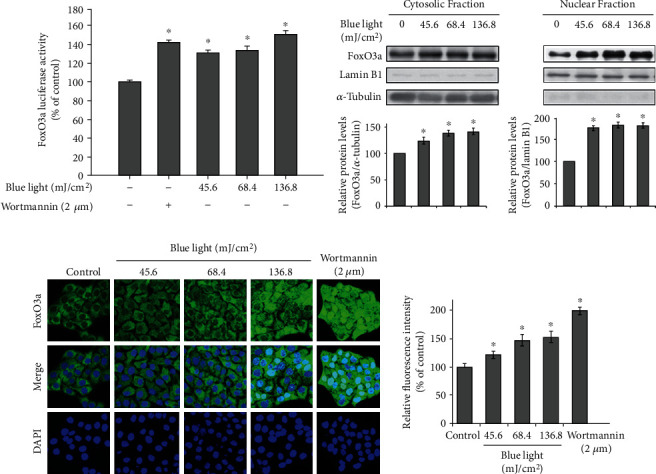Figure 3.

Blue light irradiation promotes the nuclear translocation of FoxO3a. (a) HaCaT cells were cotransfected with the FoxO3a promoter-luciferase reporter and β-galactosidase reporter vector using polyethylenimine. After 24 h, the transfected cells were incubated with the indicated intensity of blue light or treated with wortmannin (2 μM), a PI3K inhibitor. After 24 h of incubation, FoxO3a promoter-luciferase reporter activity was measured. In addition, β-galactosidase assay was performed to measure transfection efficiency. Data are presented as the mean ± SEM of four independent experiments. Statistical significance of differences among the groups was assessed by one-way analysis of variance (ANOVA), followed by Tukey's multiple comparison test, using the GraphPad Prism 5 software. ∗p < 0.05 vs. the control group. (b) HaCaT cells were irradiated with the indicated intensity of blue light. After 24 h, the cells were harvested, and the cytoplasmic and nuclear fractions were prepared using the NE-PER™ Nuclear and Cytoplasmic Extraction Reagents, respectively. The nuclear translocation levels of FoxO3a were determined by Western blotting analysis. The densitometric analysis was also performed. ∗p < 0.05 vs. the control group. (c) HaCaT cells were irradiated with the indicated intensity of blue light or treated with wortmannin. After 24 h, the cells were fixed in 4% formaldehyde solution, and FoxO3a was visualized using rabbit polyclonal antibodies, followed by Alexa 594-labeled antibody (red). Additionally, DAPI (blue) was utilized to visualize the nuclei. The relative fluorescence intensity was also analyzed. ∗p < 0.05 vs. the control group.
